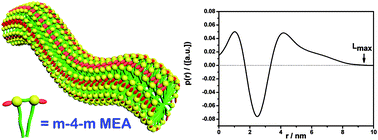The aggregation behavior of Gemini surfactants with hydroxyl groups in their headgroups, butane-1,4-bis(hydroxyethyl methylalkylammonium) bromides hereafter abbreviated as m-4-m MEA (m = 12, 14, 16), has been investigated in aqueous solution. Each formed a viscous fluid in water at low concentration in the absence of a salt. In solutions of 14-4-14 MEA, the formation of highly viscoelastic wormlike micelles could be detected using steady and dynamic rheological measurements. The existence of these long column micelles has also been confirmed using cryo-transmission electron microscopy (cryo-TEM) and small angle X-ray scattering (SAXS). Compared with conventional bis(dimethylalkylammonium) bromide Gemini molecules with the same spacer (14-4-14), 14-4-14 MEA demonstrated a better ability to fabricate wormlike micelles because of the change in the headgroup structure. As for 16-4-16 MEA, which has longer alkyl chains, its aqueous solutions behave more like elastic gels at a concentration of 80 mmol L−1. The unique viscoelastic behavior of m-4-m MEA in water can be attributed to the synergistic interactions of hydrophobic attraction and hydrogen bonding. The obtained results are believed to be an important addition to the effect that the headgroups of Gemini surfactants have on their aggregation behavior in dilute solutions.

